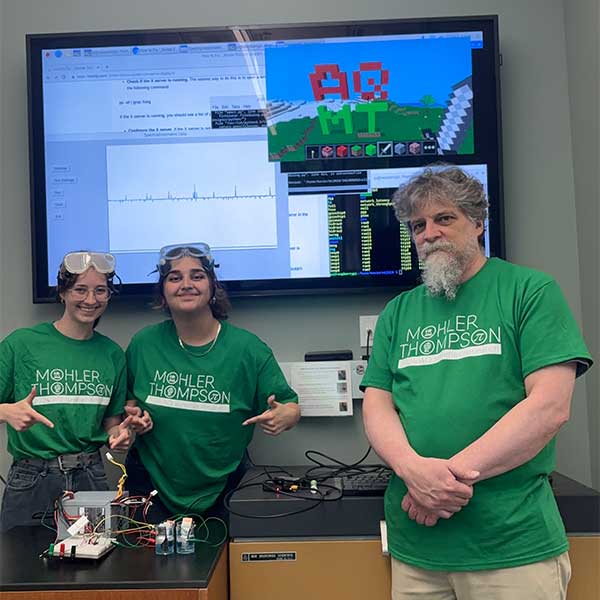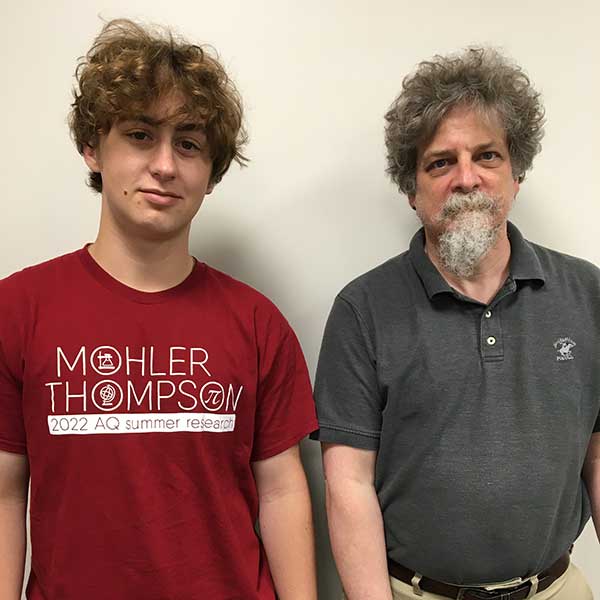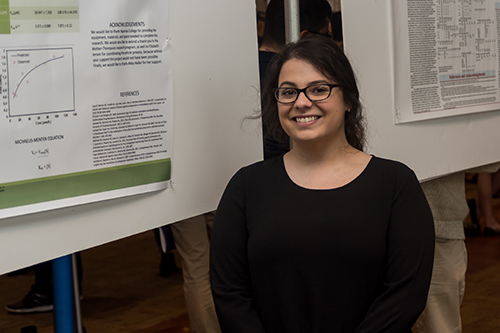Chemistry Research
Chemistry Research
May 2024 - May 2025
Characterization of organic components in soil relevant to soil carbon sequestration
Chiara Bonfissuto
 The focus of this research will be on the extraction, characterization and classification
of the organic components found in soil samples from agricultural and post-agricultural
lands. In order to extract the organic components of soil, a spectrophotometric approach
was chosen with the utilization of a single-channel spectrophotometer implemented
with a variety of target wavelengths; the results of this initial characterization
will then help direct further analysis with electrochemical and chromatographic methods
which will be followed by analysis through mathematical modeling. These organic components
play an important role in the soil’s ability to sequester carbon from the carbon dioxide
in the atmosphere; therefore the characterization of said components is important
for environmental modeling. This characterization would be accomplished via spectroscopic
analyses which would allow for the compilation of data sets broad enough not only
to perform targeted spectrophotometric and electrochemical procedures, but also to
provide a baseline collection of analyzed samples from which new research projects
may arise.
The focus of this research will be on the extraction, characterization and classification
of the organic components found in soil samples from agricultural and post-agricultural
lands. In order to extract the organic components of soil, a spectrophotometric approach
was chosen with the utilization of a single-channel spectrophotometer implemented
with a variety of target wavelengths; the results of this initial characterization
will then help direct further analysis with electrochemical and chromatographic methods
which will be followed by analysis through mathematical modeling. These organic components
play an important role in the soil’s ability to sequester carbon from the carbon dioxide
in the atmosphere; therefore the characterization of said components is important
for environmental modeling. This characterization would be accomplished via spectroscopic
analyses which would allow for the compilation of data sets broad enough not only
to perform targeted spectrophotometric and electrochemical procedures, but also to
provide a baseline collection of analyzed samples from which new research projects
may arise.
Faculty Advisor: Dr. Kevin Boyd, Chemistry
Funded by: Mohler-Thompson Summer Research Grant
The River Narrative: Development of Low-cost, Networkable Remote Sensors for Environmental Monitoring and Outreach
Ella Satterthwaite
 This project will primarily focus on the development of a network of low-cost, real-time
aquatic sensors in the Coldbrook Creek watershed, of which Aquinas College is a part.
These sensors will not only provide data on stream temperature, pH, depth, current,
turbidity and ambient daylight, but will also electrochemically assess metal, pesticide
and fertilizer content in local bodies of water. Electrochemical sensing will be accomplished
through the synthesis and development of organic polymer electrode coatings, including
molecularly imprinted polymers, for ion-sensitive field effect transistors. This process
will be informed by recent literature and computational methods. Development of project
instrumentation and data collection will also involve configuring a sub-GHz radio
system, in addition to data compression and interpretation with Fourier and wavelet-based
methods. Aiming to make water quality monitoring cheaper and less analytically intensive,
the project will ultimately contribute to Dr. Boyd’s larger River Narrative Project.
This project’s objectives include monitoring and modeling the conditions of the Coldbrook
Creek watershed and providing a source of data through a web-based interface for community
members curious about the state of local waterways.
This project will primarily focus on the development of a network of low-cost, real-time
aquatic sensors in the Coldbrook Creek watershed, of which Aquinas College is a part.
These sensors will not only provide data on stream temperature, pH, depth, current,
turbidity and ambient daylight, but will also electrochemically assess metal, pesticide
and fertilizer content in local bodies of water. Electrochemical sensing will be accomplished
through the synthesis and development of organic polymer electrode coatings, including
molecularly imprinted polymers, for ion-sensitive field effect transistors. This process
will be informed by recent literature and computational methods. Development of project
instrumentation and data collection will also involve configuring a sub-GHz radio
system, in addition to data compression and interpretation with Fourier and wavelet-based
methods. Aiming to make water quality monitoring cheaper and less analytically intensive,
the project will ultimately contribute to Dr. Boyd’s larger River Narrative Project.
This project’s objectives include monitoring and modeling the conditions of the Coldbrook
Creek watershed and providing a source of data through a web-based interface for community
members curious about the state of local waterways.
Faculty Advisor: Dr. Kevin Boyd, Chemistry
Funded by: Mohler-Thompson Summer Research Grant
May 2023 - May 2024
How much carbon is absorbed by soil and particular land uses
Noah Reilly
Lauren Whetstone
Along with Lauren Whetstone, I will be conducting research regarding the following inquiry: How much carbon is absorbed by soil and particular land uses? The research is being split up into two sections. First, we will go to various places to collect different soil samples. We will then take these soil samples and analyze them by finding their bulk density analyses using the ped/geometric approach and texture analysis using the buoyoucos method. This information will then be calculated using a cylinder and water displacement. After this, using 1- and 2-dimensional NMR, FTIR, and UV/vis (including complexation with metals) for our spectroscopic analysis and using a variety of solvents and extraction conditions we are going to try and find correlations between found characteristics and common classes of organic materials in soils, as well as correlations between the soil characteristics and carbon sequestration potential in the longer term. Ultimately, we'd like to find a simple spectroscopic methodology that can be adapted to a field-portable technique.
Faculty Advisor: Dr. Kevin Boyd, Chemistry
Funded by: Mohler-Thompson Summer Research Grant
May 2022 - May 2023

The River Narrative
Nicholas Hegenauer
A sensor array, built around the TI CC1350 and containing a variety of sensors for species of environmental interest, will be constructed and located in Wege Pond. The first type of sensor will be an ion-sensitive electrode which will be glued to capillaries. These polymers hold a placeholder molecule and when the molecule of interest binds the concentration of the measured ion, changes cell potential. An automated sampling device will be constructed to collect samples at specified time intervals. These samples will be studied later by laboratory methods such as atomic absorption spectroscopy or chromatographic methods. Finally, a ligand and metal complex sensor may be developed, when the target molecule binds to the ligand, the complex changes color triggering the sensor.
May 2021 - May 2022
Growth of Mixed-Metal Oxide Thin Films and their Optical, Electrical, and Photochemical Properties
Bryce Platte
A growth chamber will be constructed to allow for the creation of mixed-metal oxide films consisting of Titanium (IV) and another transition metal. From these films, the optical, electrical and photochemical effects will be measured. The photochemical effects of these films should have a wider absorption spectra compared to films made with only Titanium (IV) and therefore provide better absorption of energy from light. The growth chamber will be designed to allow for trials at varying temperatures to measure the structural changes at these different temperatures. The metals used for synthesis will be created in the laboratory while the chamber is being constructed.
Faculty Advisor: Kevin Boyd
Funded by: Mohler-Thompson Summer Research Grant
May 2019 - May 2020
Synthesis and Characterization of Ionic Liquid Crystal Compounds
Aaron Batke
Thermotropic liquid crystals are compounds with an intermediate phase between crystalline solids and isotropic liquids. They can be induced into phase transitions by altering their temperature. One category of liquid crystals are ionic compounds composed of metal halide ions that are attached to alkylammonium cations with positively-charged nitrogen atoms connected to a hydrophobic hydrocarbon tail. Interest in these compounds has existed for the past 45 years. Studies have involved a range of alkyl chain lengths and different transition metal halides. However, the lanthanide metals have not been sufficiently explored. We will synthesize one or more ionic liquid crystal compounds containing alkylammonium cations with samarium chloride anions. Characterization of the resulting compounds may include elemental analysis, differential scanning calorimetry, melting point analysis via Mel Temp apparatus, polarizing optical microscopy, and Fourier-transform infrared spectroscopy. We hope the new compounds will exhibit thermotropic liquid crystal phases. The presence of the lanthanide element may also cause fluorescence. This work will contribute to a previously unexplored region of chemistry.
Faculty Advisor: Elizabeth Jensen
Funded by: Mohler-Thompson Summer Research Grant
Scope of an Under Air Direct Arylation Reaction with Respect to Aryl Halides
Gabby Brandonisio
Direct Arylation is a type of reaction used by organic chemists to cleave C-H bonds on aromatic compounds and form C-C bonds with other aromatic compounds. Typically these reactions are done under an inert atmosphere, but previous Aquinas students that have studied this reaction using air and obtained yields just as good. The previous students have found optimal conditions for the reaction to take place. Building off of their research, our goal is to explore the scope of the reaction with respect to the aryl halides.
Faculty Advivor: Dr. Jonathan Fritz
Funded by: Mohler-Thompson Summer Research Grant
May 2018 - May 2019
Kinetic Studies of OXA-207
Avery Cheap
We are studying the enzyme kinetics of OXA-207, a Class D beta-lactamase. Beta-lactamases catalyze the hydrolysis of beta-lactam antibiotics, a broad class of widely used antibiotics. By doing so, the beta-lactamase can confer antibiotic resistance to the microbe that expresses it.
 OXA-207 differs from its parent enzyme by just one amino acid. We are measuring the
kinetics using a bevy of different beta-lactam substrates.
OXA-207 differs from its parent enzyme by just one amino acid. We are measuring the
kinetics using a bevy of different beta-lactam substrates.
Faculty Advisor: Dr. Tim Henshaw
Funded by: Mohler-Thompson Summer Research Grant
May 2017 - May 2018
Kinetic Studies of OXA-207
Jacob Mackinder
Beta-lactamases are enzymes that catalyze the hydrolysis of beta-lactam antibiotics (e.g. penicillin) and confer antibiotic resistance to the bacteria that produce them. We are studying an example of a Class D beta-lactamase, OXA-207, which differs from its parent enzyme by only one amino acid, but exhibits distinctly different substrate preferences. We hope to fully characterize the substrate profile of OXA-207 and possibly investigate the structural reasons for the differences.
Faculty Advisor: Dr. Tim Henshaw
Funded by: Mohler-Thompson Summer Research Grant
May 2016 - May 2017
Structural Effects of Buchwald Ligands in Direct Arylation Reactions
John McAfee
Buchwald ligands are a common choice for direct arylation reactions because of their poor electron density. I will be researching the effects of the structures of these ligands in direct arylation in order to better understand which ligand should be used. Direct arylation could promote advances in the pharmaceutical and solar industries.
Faculty Advisor: Jonathan Fritz
Funded by: Mohler-Thompson Summer Research Grant